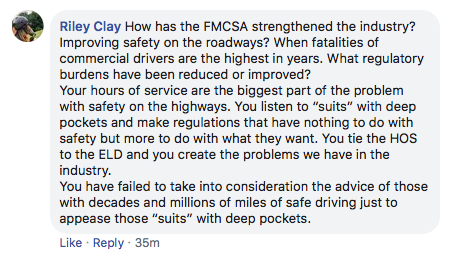FMCSA boasts about year’s ‘accomplishments’ in spite of a troubled 2019 for trucking

Yesterday, the Federal Motor Carrier Safety Administration (FMCSA) shared an end-of-the-year rundown of their “accomplishments” in 2019 that left several members of the trucking community confused and angry.
On December 30, the FMCSA released a recap of their 2019 ‘achievements and key priorities for improving safety on the nation’s roadways with large trucks and buses.’
You can view the FMCSA’s list of 2019 accomplishments below:
Historic Hours of Service Proposal: In August 2019, FMCSA proposed historic reforms to the existing hours of service regulations to improve safety and increase flexibility for commercial vehicle drivers. This proposal contains five key updates to hours of service rules which are directly based on the feedback FMCSA has received from drivers across the country. The proposal is also estimated to provide $274 million in savings for the U.S. economy.
Improving Regulatory Efficiency: Over the year, FMCSA proposed several important regulatory reforms that result in over $366 million in savings for the American economy. In March, the Agency proposed updating Entry-Level Driver Training regulations to save $18 million, and in August the Agency published its hours of service proposed rule that is estimated to save $274 million, and September, FMCSA proposed $74 million in regulatory savings be reducing burdensome rules on commercial buses.
Critical Grant Funding: In 2019, FMCSA awarded $77.3 million in grants to states and educational institutions to enhance commercial motor vehicle (CMV) safety. In September, the Agency awarded $43.3 million in High Priority (HP) grants, and $32 million in Commercial Driver’s License Program Implementation (CDLPI) grants throughout the country. FMCSA alsoawarded $2 million in Commercial Motor Vehicle Operator Safety Training grants to sixteen education institutions to help train veterans for jobs as commercial bus and truck drivers.
Supporting Military Servicemembers: In June 2019, FMCSA officially launched its Under-21 Military Driver Program— a pilot program to permit 18-20-year old’s who possess the U.S. military equivalent of a commercial driver’s license (CDL) to operate large trucks in interstate commerce. This program is designed to help the brave men and women who serve our nation the opportunity to explore quality job prospects in interstate trucking. In October, the Agency announced the creation of a new job opportunities listing page which contains approved motor carriers who are currently hiring under-21 military drivers as part of the pilot program.
Fighting Human Trafficking: In July 2019, FMCSA announced a final rule that permanently bans drivers convicted of human trafficking from operating a commercial vehicle for which a commercial driver’s license or a commercial learner’s permit is required. Under Secretary Chao’s leadership, combatting human trafficking has been a priority for the Department—including the creation of the Secretary’s Advisory Committee on Human Trafficking. Deterring human trafficking in America’s commercial transportation industry is just one step in the Trump Administration’s commitment to fighting against these abhorrent crimes.
Helping People Find Jobs in Trucking: In 2019, FMCSA prioritized efforts to make it less burdensome for men and women interested in entering the trucking workforce to obtain and upgrade their commercial driver’s license (CDL). In March 2019, FMCSA proposed a final rule streamlining the process and reduce the costs to upgrade from a Class B to Class A Commercial Driver’s License (CDL). The final rule will save eligible driver trainees and motor carriers $18 million annually.
Exploring New Technologies: In July, FMCSA published an advanced rule to seek input on the removal of unnecessary regulatory barriers to the safe introduction of automated driving systems (ADS) vehicles in the United States. The Agency’s goal is to continue gathering information on how best to ensure safety rules are kept up to date and do not hamper the ongoing development of possible life-saving technologies in the trucking marketplace.
Raising Awareness of Large Truck & Bus Safety: In 2019, FMCSA’s Our Roads, Our Safety partnership for responsible driving grew to 27 partner organizations across industry, safety, and driver education stakeholders. The Agency also released its “Voices of Safety” campaign—a video series and national public awareness campaign designed to raise awareness among all road users about sharing the road safely with large trucks and buses. The 2019 public awareness campaign achieved an overall reach of more than 359 million views in markets and platforms across the nation.
2019 in Trucking: The Struggle was Real
Several members of the trucking community took to Facebook to call out the FMCSA for their congratulatory tone in a year when the trucking industry struggled.



In October 2019, the National Highway Traffic Safety Administration (NHTSA) shared startling new statistics that indicated that in the first full year of the ELD Mandate being in effect, fatal crashes involving large trucks increased by 0.9%. Additionally, large truck occupant fatalities also increased by 0.8% to 885 in total for 2018. This marks the highest rate of large truck occupant crash deaths since 1988, when 911 people lost their lives. Additionally, a December 17 report from the U.S. Bureau of Labor Statistics showed that ‘truck driver’ topped the list of deadliest occupations in the U.S. in 2018.
And while the FMCSA finally debuted their long awaited Hours of Service Notice of Proposed Rule Making (NPRM) in August 2019, many members of the trucking community felt that the changes did not provide enough of the promised “flexibility” for drivers. Additionally, in spite of the fact that the comment period for the NPRM has been closed for more than two months, there has been no word on when the Final Rule will be published.
The FMCSA also drew ire from trucking groups like OOIDA this year when they delayed the decades-in-the-making driver training rule by two years. In late November 2019, the FMCSA announced that they were moving back the compliance date from February 7, 2020, to February 7, 2022 to allow state drivers license agencies time to update their IT infrastructure, internal procedures, and budgeting allocation to properly record driver course completion information.
This year, we also saw the head of the FMCSA, Administrator Raymond P. Martinez, step down in October without a replacement. Late in 2019, the FMCSA announced a 50% increase to the random drug test rate that is expected to cost the trucking industry $50 to $70 million in the coming year. Worst of all, thousands of drivers lost their jobs this year after a difficult freight market caused in part by an increased regulatory burden forced hundreds of trucking companies large and small to close.